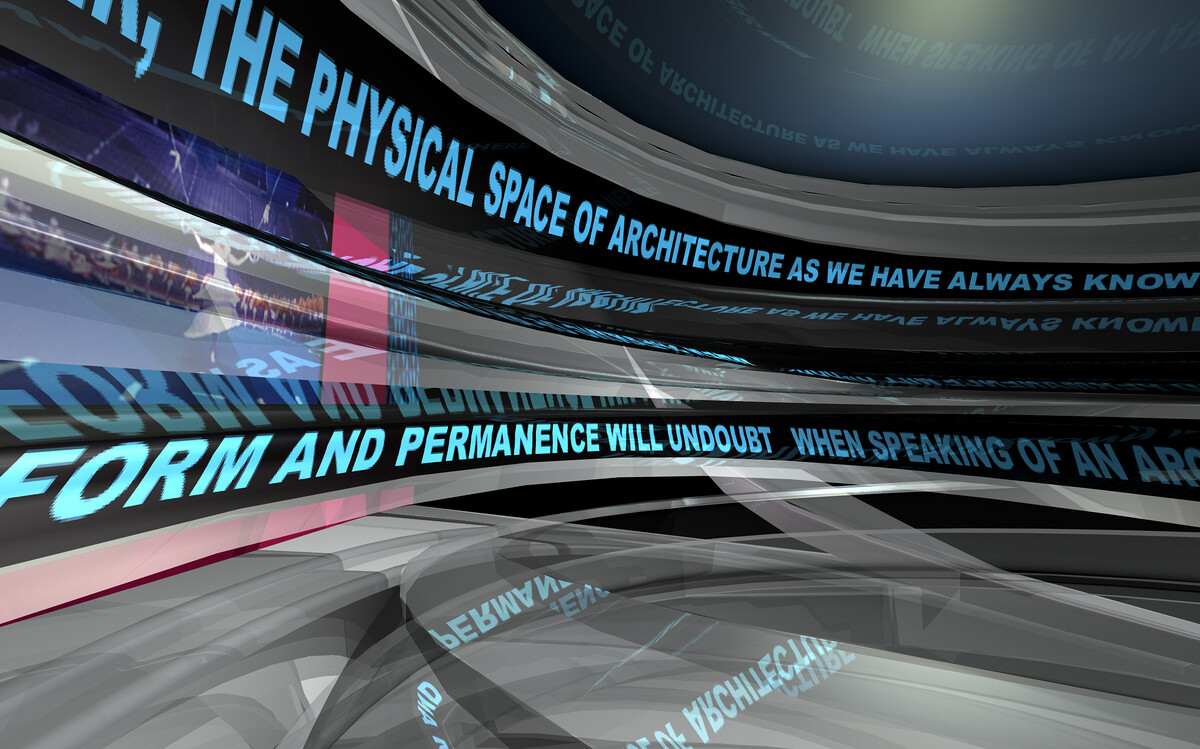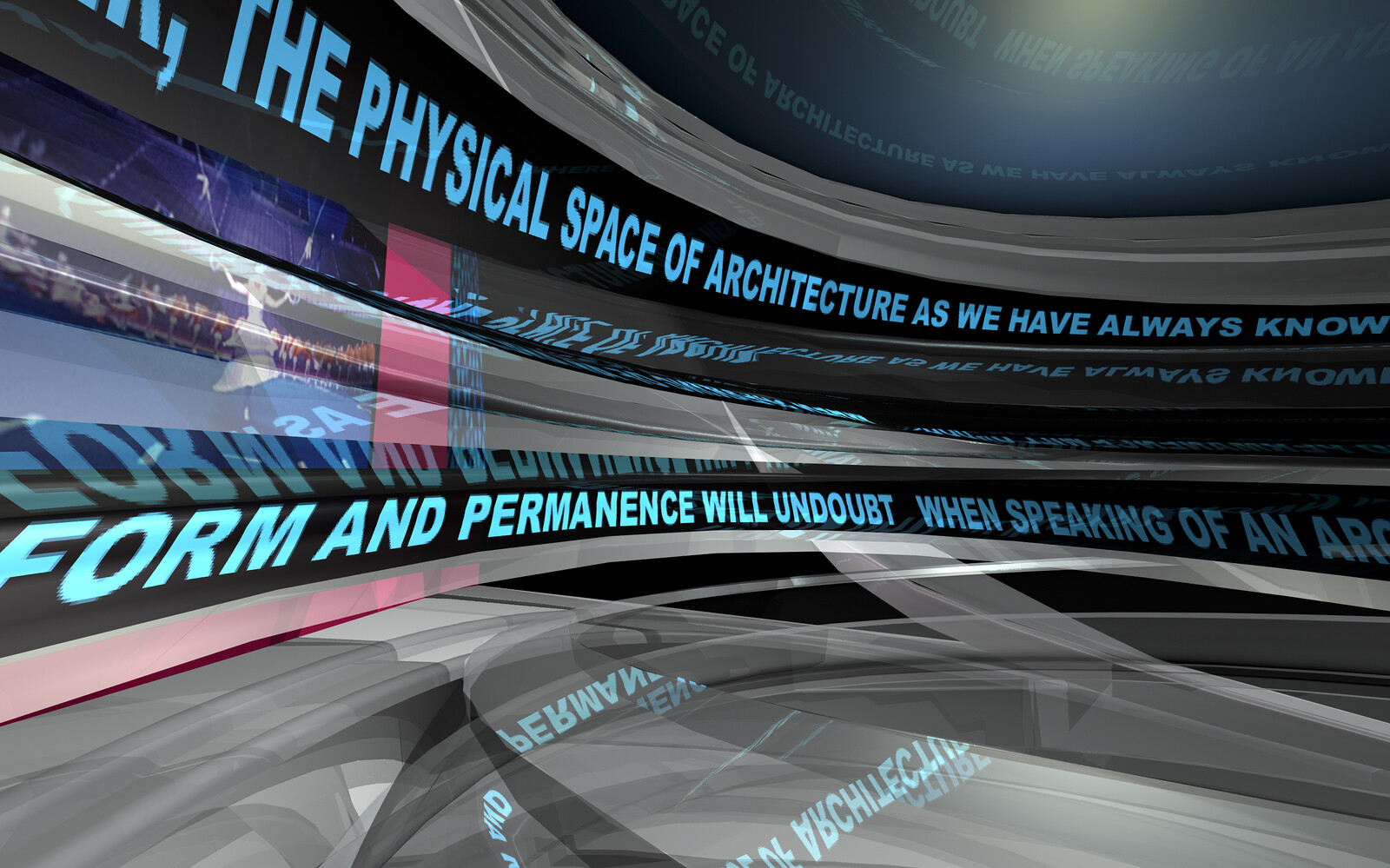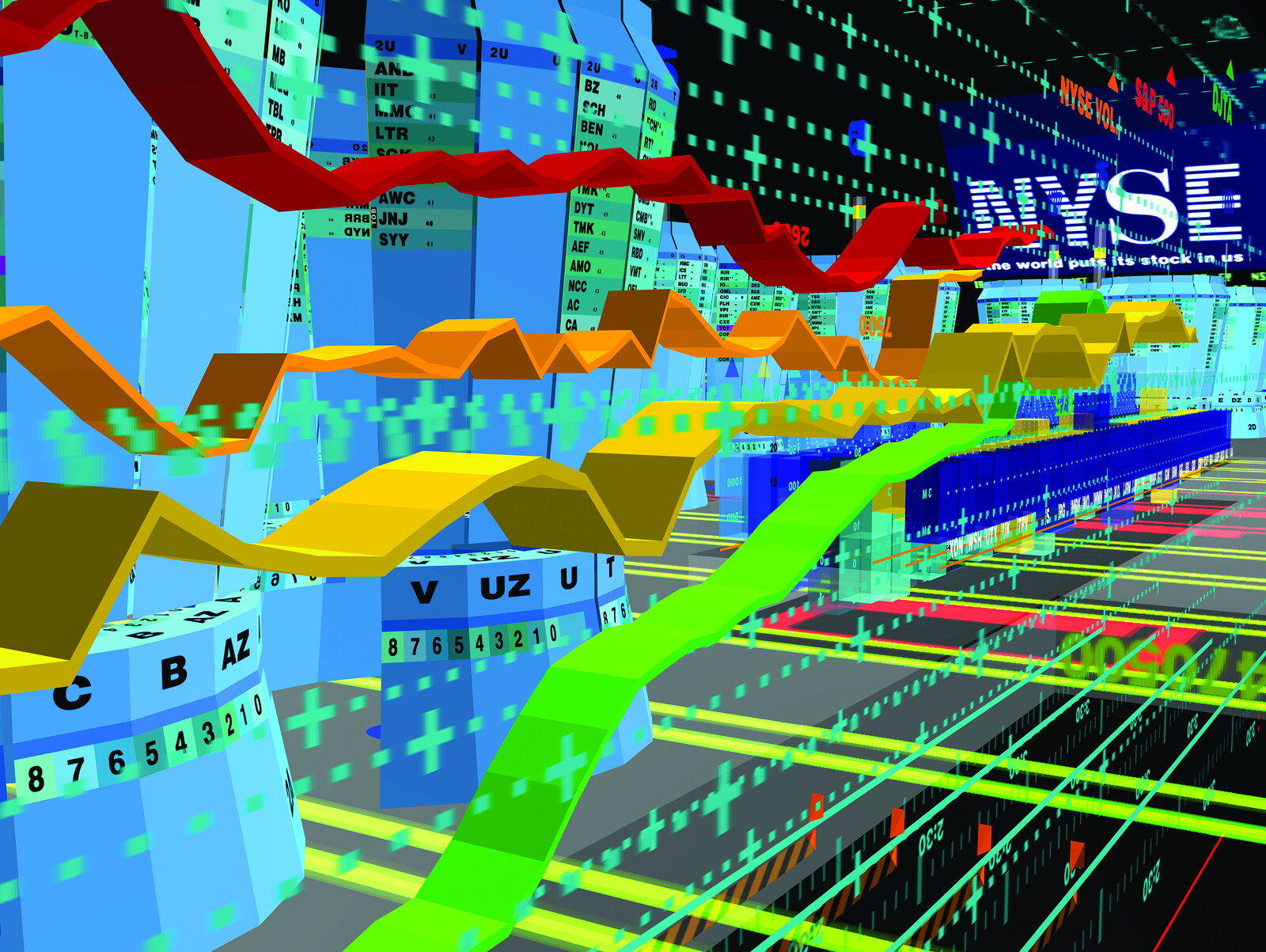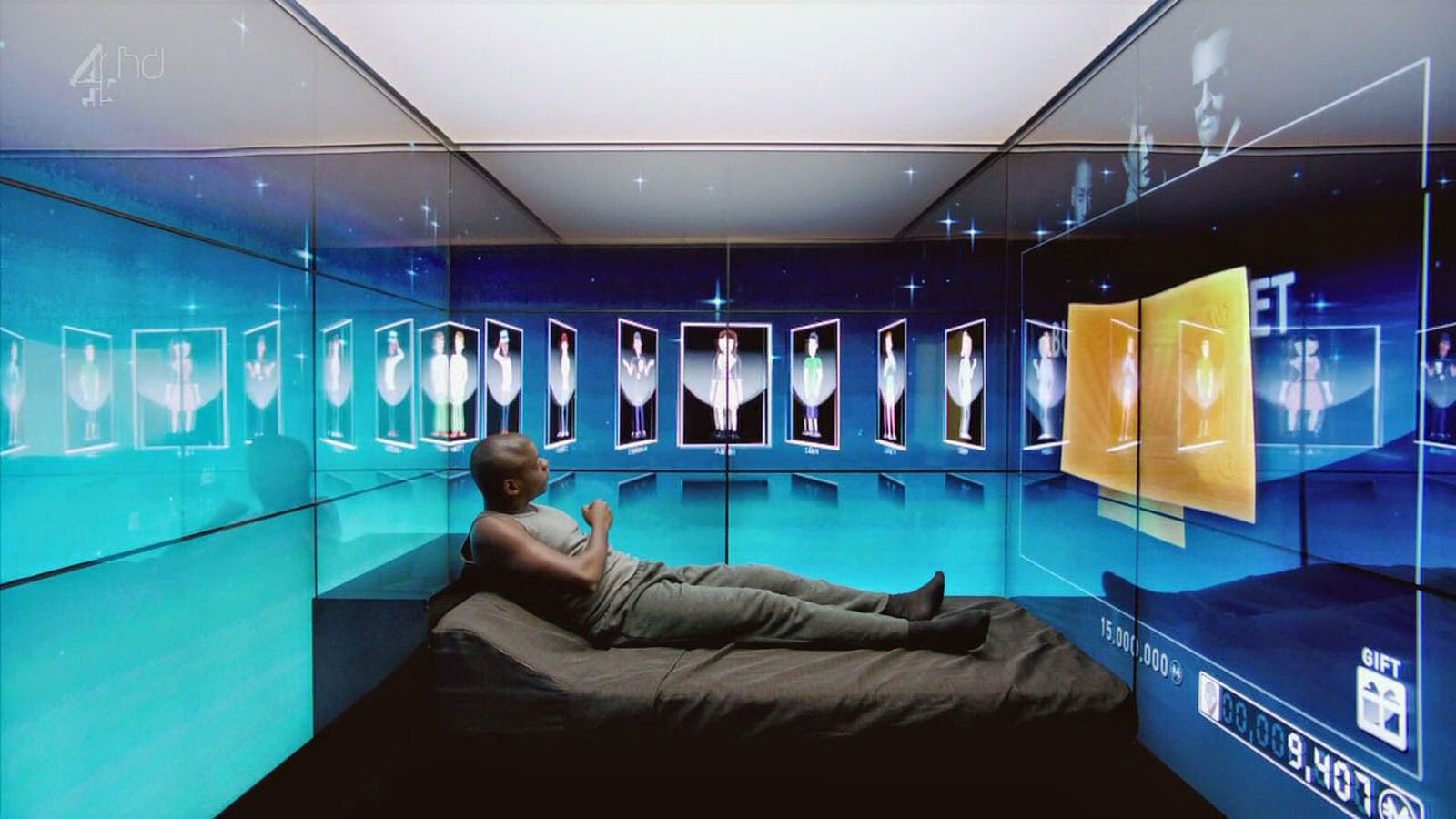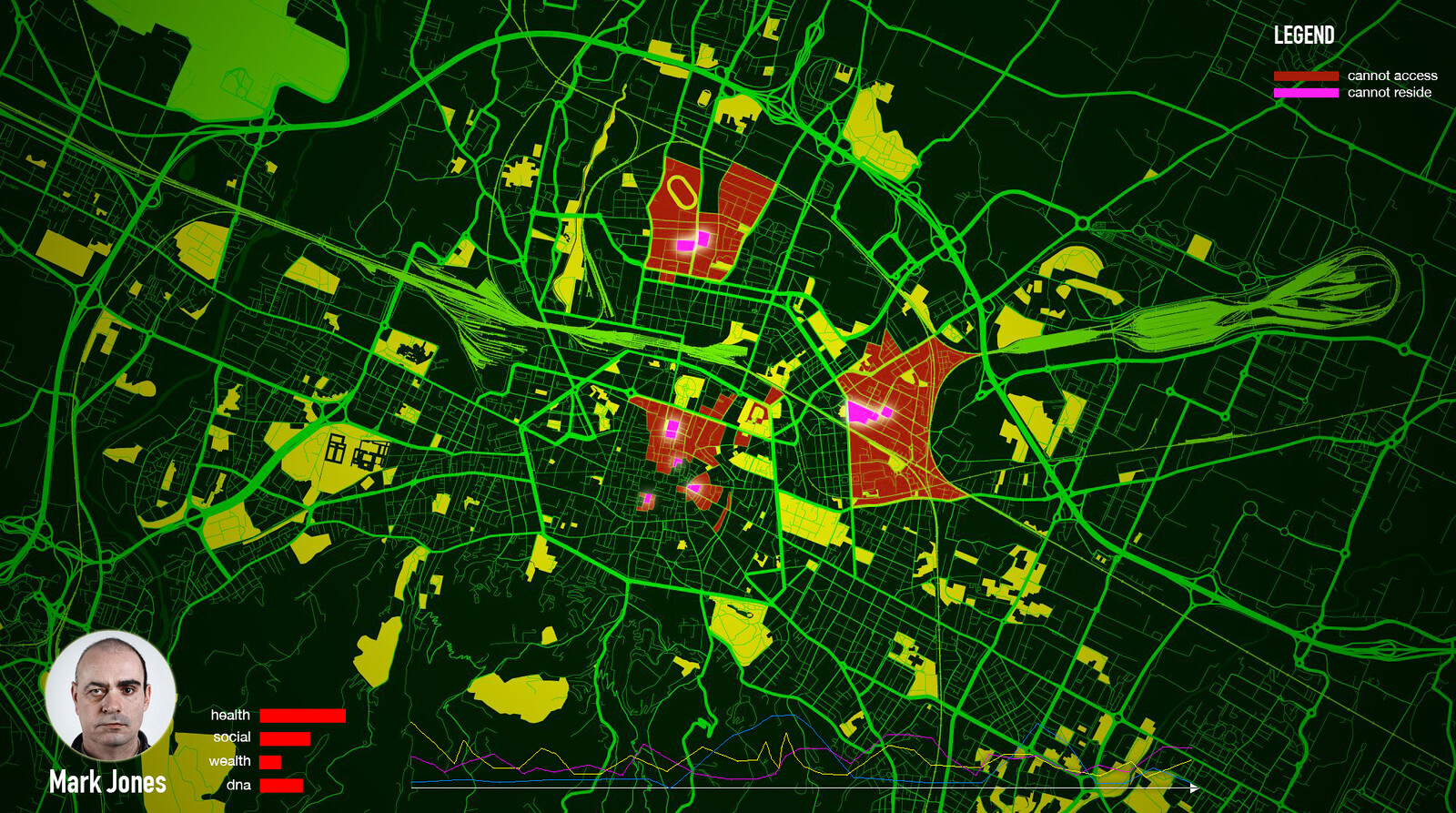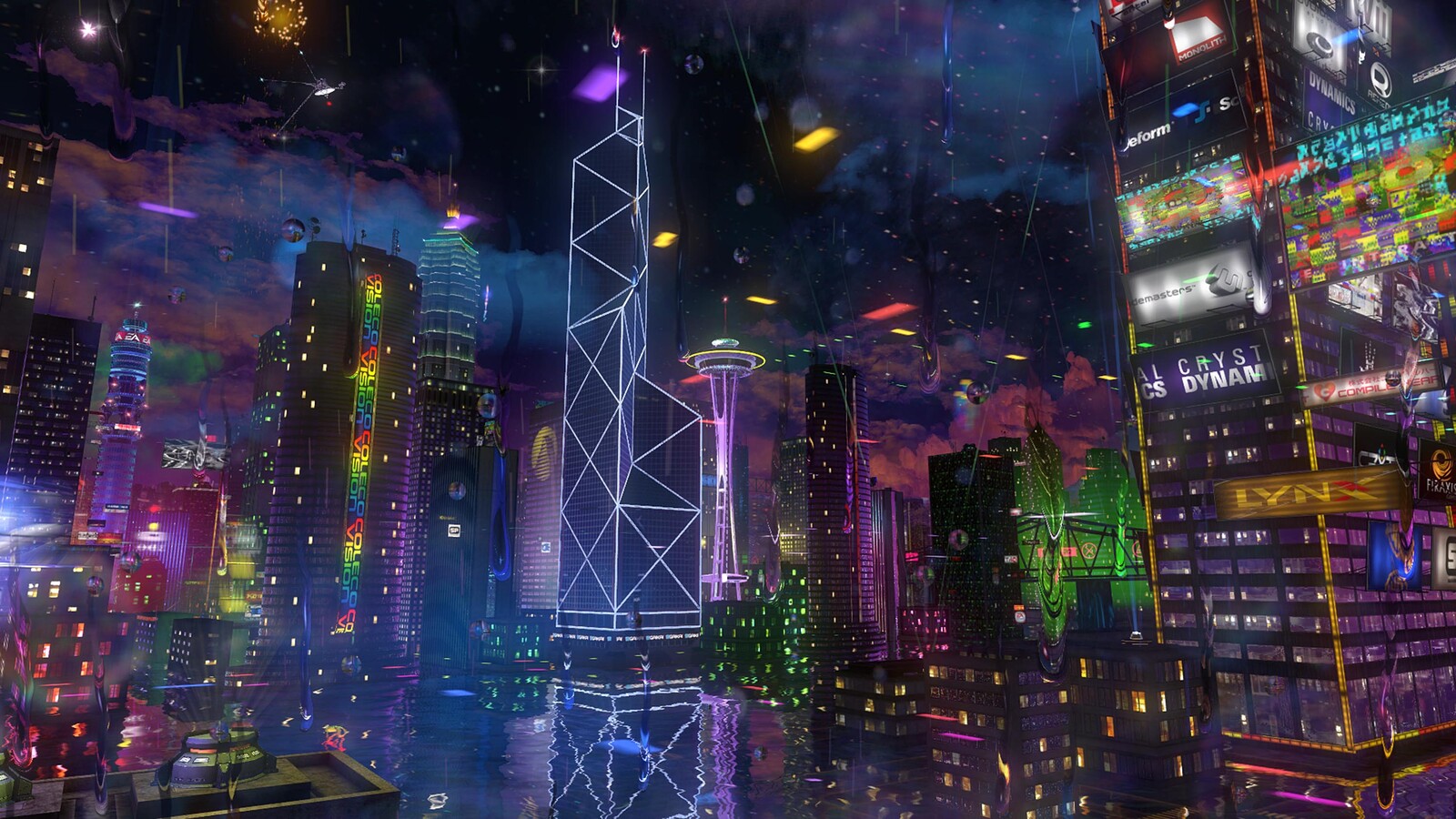The hand sketch or physical maquette has always been an essential tool for architects in the constant search for new form(s) and spatialities. In the late 1990s, with the advent of virtual reality, other means of exploring possibilities for architecture emerged. In that early period, projects that utilized virtual reality typically harnessed the expertise of computer programmers, computer interface designers, and software engineers. However, in 1998 the New York Stock Exchange (NYSE) approached my architectural practice, Asymptote, to design a state of the art virtual reality environment. A second commission by the Solomon R. Guggenheim Museum soon followed, and while the needs and intended audience of a cultural organization differed from that of a financial institution, the goals were very similar. We set out to design a fully interactive computer generated environment for each that would afford new ways of disseminating and providing access to data-rich and complex environments.
As virtually “inhabitable” entities, both projects were unprecedented “architectural environments.” Although the experience of virtual reality during that period was achieved through interaction with moving images displayed on screens, the seeming inevitability of new technologies such as today’s Microsoft’s HoloLens, Facebook’s Oculus Rift headsets, and Xybernaut’s retina projection technology not only inspired the project’s conceptualization and design, but also an idea of its future potential. As we increasingly head towards the merging of real and virtual worlds, progressively greater and more intriguing opportunities become available.
A Market of Data
The Virtual New York Stock Exchange (3DTF), designed in 1999 and implemented in the early 2000s, is a multidimensional real-time interactive virtual world designed to enable the NYSE operations group to access and navigate critical data and information. The 3DTF is effectively a collection of interactive “objects” in virtual space that display “live feed” data, news, market indicators and other relevant stock information. Although loosely based on the physical space of New York Stock Exchange’s trading floor, the 3DTF Virtual Trading Floor (VTF) is the architectural manifestation of a data ecosystem. Real-time market data streamed into the 3DTF allows users to filter, correlate and drill down on vast arrays information, statistics and news. Users navigate “fly-throughs,” zoom in and out, and interact with data collections that are all set within a three-dimensional virtual world.
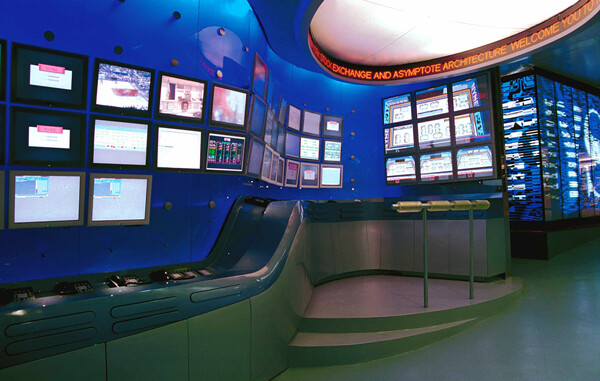

Photograph of the Advanced Trading Floor, with the Virtual Trading Floor displayed on the rear monitors. Asymptote, Virtual New York Stock Exchange (3DTF), 2000.
Another key component of the project was the design and implementation of the new 3DTF Advanced Trading Floor (ATF), a physical space that was conceived of as the command center for the NYSE operations team. Located at the very center of the actual NYSE trading floor on Wall Street, the 3DTF ATF would display the VTF across an array of large format flat screen monitors. The 3DTF ATF continues to this very day to be a dynamic hub at the very center on the NYSE trading floor.
A Museum of Pixels
The Guggenheim Virtual Museum (GVM) was initiated by the New York-based Solomon R. Guggenheim for entirely different purposes: to become a unique cultural destination on the internet.1 The ambition was to create the first fully functional virtual museum dedicated to exhibiting and showcasing internet art, as well as to provide an online digital archive for all other forms of new media art. Our primary focus then was to develop a fully interactive and “immersive” architecture that would afford visitors the possibility to access, peruse, interact with and further explore contemporary mediated and technological art forms. Within a dynamic 3D environment, the GVM housed digital portals that linked to the Museum’s collection of interactive digital artworks as well as to a host of other visual, textual, filmic, and sonic based contemporary new media works. Comprised of a fluid and ever-changing array of responsive architectural objects, the GVM provided its online audience with a uniquely spatial experience.
As with the 3DTF, the GVM also had a considered relationship with the physical world. For Thomas Krens, the Guggenheim’s director at the time, the GVM was a new type of global museum where visitors, artists, curators, researchers, and critics could interact with and experience art in new ways. The GVM was understood as building upon and adding to the existing “first-reality” Guggenheim venues in Bilbao, Berlin, Venice and New York. The idea that the virtual architecture could be part of an extraordinary architectural legacy, from Frank Lloyd Wright to Frank Gehry, fueled the architectural ideas that drove the spatial design and formal development of GVM.
These two projects for the Guggenheim and New York Stock Exchange represent a crucial moment in the history of digital culture and were effectively the first steps towards a new understanding of the built environment and its future. Designing these projects profoundly impacted our understanding of what a “real” architecture is or might be. Furthermore, because of the many ways in which architecture is conceived of and represented, the manifestation of virtual architecture is not new. From Piranesi’s fantastical and impossible drawings to Friedrich Kiesler’s intricate cerebral worlds, the notion of another realm that transcends gravity, building materials, and even physics has endured throughout the history of the discipline. The airborne fantasies of Bruno Taut’s buildings that were to leap over the Alps, the fantastically dark and other-worldly visions of Lebbeus Woods, and the orbiting megacities of Paolo Soleri, are all delirious manifestations of where architecture could go if only untethered to “reality” as we know it. The “virtual” has always provided a release not only from the shackles of gravity and current technological limitations, but also from the political and philosophical forces of the time. We look back on these eloquent and profound visions as being surreal and uncanny, perhaps even marginal, yet within these awe-inspiring provocations the true art form of architecture perseveres. Earlier forays into virtualization, from Claude-Nicolas Ledoux and Étienne-Louis Boullée to later works by Archigram, Superstudio, and Haus-Rucker-Co, form the foundations of current explorations into Virtual Reality Architecture. Digital tools have nearly infinite capabilities to provide architects with entirely novel ways to explore space and meaning, generating new and unanticipated forms of abstraction. Research into this domain is critical for architects who are active agents in both the “real” and virtual worlds that we now traverse with ever increasing intensity.
The Museum of the Present Future
The motivations and preoccupations we discovered and developed at the time of these early projects continue today in our ongoing search for new spatialities and forms. The notion of making space time-based and malleable in VR, for example, makes us consider how we might make a physical architecture fluid, elastic and in a seemingly constant state of flux. Within the development of our design for the Museum of the Present Future for the State Hermitage Museum in Russia, many of the ideas that first came to light in these early projects and discussed here have come to the surface. The recognition that the digital realm has influenced and shaped how we think of the “real” today has instigated a further interest towards making what we might call the “unseen.” The pursuit of the virtual in architecture begs the question: what is a corollary experience, drawn from the virtual, that can be applied to “real” space and “actual” architecture?
We find before us today compelling technologies that, despite current limitations, promise even more immersive, uncanny and strange experiences. As they are advanced, the delicate balance between the virtual and the real will continue to shift, while the boundaries between the physical and the virtual become more porous, fluid, transformative, mutational and enigmatic. Alongside this, the emergence of radical new art forms are redefining how we think about “seeing” and “displaying” art, especially within the confines of a physical museum. For a wide percentage of the museum-going public today, the museum experience is predicated on having already “experienced” the content, i.e. having already “seen” it, albeit virtually or in some other mediated form. Therefore today more than ever, the experience of a “real” museum has the potential to confront and undo its audience’s expectations and challenge a priori thinking. The art of today and tomorrow will undoubtedly find a foothold in this real-versus-virtual dialog. In the shape-shifting environment where museums struggle to attract audiences and artists strive to confront, art will invariably find new ways to be relevant. It is with this in mind that our new Hermitage Museum seeks to delineate spaces where the overlap between expectations, memory and experience forge the interiority, circulation, and form.
The Hermitage Modern Contemporary Museum in Moscow is a direct response to these radical perceptual and experiential shifts. The buildings multilayered exterior puts the architecture and building into a constant state of flux and ambiguity. Reflected, refracted, transmitted, and filtered light all play against a seemingly solid yet fluid exterior. The interior volumes and circulation call into question the stasis of the “white cube” gallery and “black box” temporary spaces, thereby creating a constant overlay of one onto the other and the possibilities for experimentation and the curation intermingle. Our design for the Hermitage Museum is a physical enactment of many of the phenomena that we have drawn from “virtual” architecture. The notion of being profoundly untethered to the perceived boundaries of physical space affords us the opportunity to “perform” museological spaces that strive to be lyrical and enigmatic, discursive and phenomenological, and above all unexpected and engaging. The Hermitage Modern Cotemporary seeks to become a contemporary art museum whose shape-shifting, transformational architecture embraces the real-virtual reality that we now traverse without reservation.
The revival of the hyperreal
It might be interesting today to come back full circle regarding notions and concepts of architectural experience and visualization. This is particularly evident if we consider how we look at and understand art, both historically and today. For the ancient Greeks and Egyptians, art was a means of moving the narratives and meaning of reality beyond itself and into a transcendent domain of the hyperreal. From Renaissance and Baroque art up through to modern photography, film, video, electronic art, and now the advent of the virtual, we seem to be on a circuitous path backwards and through similar notions of exploring our worlds in this continuum of visualizing and making the hyperreal evident. The intensely accurate and exaggerated larger than life busts of Ron Mueck, or the precise optical surveillances and spectral works of Olafur Eliason, for example, both attest to this shift in visualization and art making. One could similarly reference the exaggerated caricature-like oil painting of John Currin, or the emotional and strange installations and works of Erwin Wurm. Importantly, common to all of these examples is that the hyperreal visions of the reality that surround us today are increasingly being confronting within contemporary architecture.
Designing a contemporary art museum today is in some respects a parallel trajectory where we are moving from abstraction to a newfound post-visual and post-technological hyperreality. Take, for instance, the design of Frank Lloyd Wright’s Guggenheim New York, Marcel Breuer’s Whitney Museum, and Frank Gehry’s Guggenheim Bilbao. While these are only three of many examples of twentieth century architecture’s trajectory through abstract form and place making, it is sufficient to note that the paradigm has shifted with more recent buildings such as Herzog & de Meuron’s Tate London, SF Moma by Snøhetta, or the New Museum in New York by SANAA. While the former set is comprised of sculpted architecture that in turn shape the way art is exhibited and experienced, the latter give way to benign containers exaggerated in scale. As art migrates increasingly into the realms of the hyperreal, the architecture and spaces that will house such work need retooling. Architecture ultimately needs to evolve away from what we have traditionally thought of as pristine galleries and agnostic spaces for “display.” The process of rethinking “museum” architecture today must take into consideration the impact of all different types of new and on-the-horizon technologies where VR and AR are but two of many profound ways of thinking and seeing the world that are already affecting the production and experience of art. Add to these voice control, visual and sensory response systems, artificial intelligence, robotics, and machine learning, and the changes become ever more nuanced and complex, with the potential to radically shift museum culture itself. Our notions of what is thought of and experienced as “real” increasingly results from a profound shift in the interface between technology and space. The architecture of the hyperreal meets these radical shifts in technology, perception, and experience head on.
The question today is not so much what forms or architecture will these transformations influence, but rather what aspects of our thinking and our comprehension of how to navigate reality and space are shifting and changing. By extension, we may ask what do such changes demand of the experiences we have (and desire to have) within the spatial realms? To remain relevant beyond merely building a house for art (or people), the spatial and tectonic results of what we create as architects needs to address this new, ever-shifting collective cultural realm.
The Guggenheim Virtual Museum (GVM) was initiated by Senior Curator of Film and Media Arts John Hanhardt and Curator Matthew Drutt with the support of the Bohen Foundation.
Post-Internet Cities is a collaborative project between e-flux Architecture and MAAT – Museum of Art, Architecture and Technology within the context of the Utopia/Dystopia exhibition and “Post-Internet Cities” conference, produced in association with Institute for Art History, Faculty of Social Sciences and Humanities – Universidade NOVA de Lisboa and Instituto Superior Técnico – Universidade de Lisboa, and supported by MIT Portugal Program and Millennium bcp Foundation.
Category
Post-Internet Cities is a collaborative project between e-flux Architecture and MAAT – Museum of Art, Architecture and Technology within the context of the Utopia/Dystopia exhibition and “Post-Internet Cities” conference, produced in association with Institute for Art History, Faculty of Social Sciences and Humanities – Universidade NOVA de Lisboa and Instituto Superior Técnico – Universidade de Lisboa, and supported by MIT Portugal Program and Millennium bcp Foundation.
